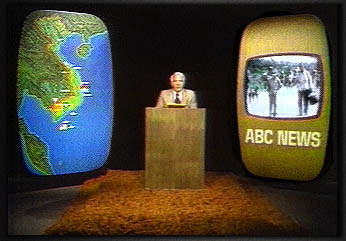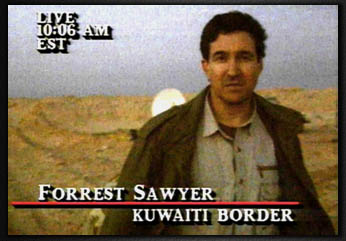Video and Television News Production
 The introduction of video technology into the industry of television news
production forever changed the industry. The technology of the videotape as opposed to actual
reels of film significantly reduced the time and effort needed to edit any visual and audio signals in the studio. The latest in satellite technology enables video signals to be transmitted between virtually any two points on the earth instantaneously. In recent history, several events have taken place which can be seen as milestones in the evolution of news
production. For example, during the latter stages of the Vietnam Conflict in the 1970s, video and satellite technology facilitated the same-day viewing of the war's events by Americans, just as the Gulf War
The introduction of video technology into the industry of television news
production forever changed the industry. The technology of the videotape as opposed to actual
reels of film significantly reduced the time and effort needed to edit any visual and audio signals in the studio. The latest in satellite technology enables video signals to be transmitted between virtually any two points on the earth instantaneously. In recent history, several events have taken place which can be seen as milestones in the evolution of news
production. For example, during the latter stages of the Vietnam Conflict in the 1970s, video and satellite technology facilitated the same-day viewing of the war's events by Americans, just as the Gulf War
 was the first war to be broadcast live to a nation. Other events reflect the raw power that visual images possess to emotionally influence its audience. Examples of such include the horrific Challenger Disaster in 1986, as well as the riot-provoking
private videotape of Los Angeles police officers beating Rodney King in 1991. Also interesting is the fact that the aforementioned technological advances in the industry, coupled with the unique circumstances of the Gulf War, aided the
television news network CNN to soar in popularity and importance nationally, as well as worldwide.
was the first war to be broadcast live to a nation. Other events reflect the raw power that visual images possess to emotionally influence its audience. Examples of such include the horrific Challenger Disaster in 1986, as well as the riot-provoking
private videotape of Los Angeles police officers beating Rodney King in 1991. Also interesting is the fact that the aforementioned technological advances in the industry, coupled with the unique circumstances of the Gulf War, aided the
television news network CNN to soar in popularity and importance nationally, as well as worldwide.
Video and Politics
Video has many implications in the world of politics. Video technology is used in election campaigns, for television advertisements and candidate debates. Political testimonies on videotape, as in the current investigation of President Clinton, complicate legal matters in the usage of the video. Another im plication of video technology in the political world is its role in forming personas recognizable to the voting public. Video has many uses in foreign relations as well as effects on governmetnal policy and procedure. Some of the implications video techn ology has in terms of foreign policy include effects on political decisions, military operations, terrorist situations, government procedures with political prisioners and public opinion. Video is also used as propaganda in cultural exchanges and global conflicts. Furthermore, video technology is changing the courtroom. From videotaped court records to videotaped crimes and confessions, video is used as evidence in national as well as international courts.

